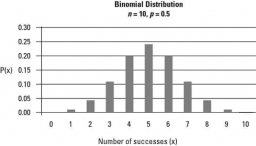Mortality tables
Mortality tables enable actuaries to obtain the probability that a person will live a specified number of years at any age. Insurance companies and others use such probabilities to determine life insurance premiums, retirement pensions, and annuity payments. According to tables provided by the National Center for Health Statistics in Vital Statistics of the United States, a person of age 20 has about an 80% chance of being alive at age 65. Suppose three people of age 20 years are selected at random.
a. Formulate the process of observing which people are alive at age 65 as a sequence of three Bernoulli trials.
b. Obtain the possible outcomes of the three Bernoulli trials.
c. Determine the probability of each outcome in part (b).
d. Find the probability that exactly two of the three people will be alive at age 65.
e. Obtain the probability distribution of the number of people of the three who are alive at age 65.
a. Formulate the process of observing which people are alive at age 65 as a sequence of three Bernoulli trials.
b. Obtain the possible outcomes of the three Bernoulli trials.
c. Determine the probability of each outcome in part (b).
d. Find the probability that exactly two of the three people will be alive at age 65.
e. Obtain the probability distribution of the number of people of the three who are alive at age 65.
Final Answer:

Tips for related online calculators
You need to know the following knowledge to solve this word math problem:
Related math problems and questions:
- Effectiveness 80811
 According to clinical studies, the effectiveness of the drug is 90%. The doctor prescribed the medicine to eight patients. What is the probability that the drug will be effective in all these patients?
According to clinical studies, the effectiveness of the drug is 90%. The doctor prescribed the medicine to eight patients. What is the probability that the drug will be effective in all these patients? - Rich retirement
 Healthcare issues are receiving much attention in both academic and political arenas. A sociologist recently surveyed citizens over 60 years of age whose net worth is too high to qualify for government health care but who have no private health insurance.
Healthcare issues are receiving much attention in both academic and political arenas. A sociologist recently surveyed citizens over 60 years of age whose net worth is too high to qualify for government health care but who have no private health insurance. - Yarhands
 Yarhands Statistical Consult conducted statistical analysis on the election results from 1992 to 2012 to assess the chances of the NPP winning the election in Ghana's Volta region. The research reveals that 15% of inhabitants in the Volta region favor the
Yarhands Statistical Consult conducted statistical analysis on the election results from 1992 to 2012 to assess the chances of the NPP winning the election in Ghana's Volta region. The research reveals that 15% of inhabitants in the Volta region favor the - Population variance
 60% of students at a California community college will transfer to a college in the CSU system. The number of students in a sample who will transfer follows a binomial distribution. If eight students are randomly selected, find the population variance σ²
60% of students at a California community college will transfer to a college in the CSU system. The number of students in a sample who will transfer follows a binomial distribution. If eight students are randomly selected, find the population variance σ² - Students 34
 Students were surveyed as part of a Statistics project to determine if younger adults are more likely to have tattoos. The results are listed in the two-way table below: age; At least one tattoo; No tattoo; Row totals Age 18 - 29; 165 ; 342; 507 Age 30 -
Students were surveyed as part of a Statistics project to determine if younger adults are more likely to have tattoos. The results are listed in the two-way table below: age; At least one tattoo; No tattoo; Row totals Age 18 - 29; 165 ; 342; 507 Age 30 - - Covid-19
 Data showed that 22% of people in a small town were infected with the COVID-19 virus. A random sample of six residents from this town was selected. Find the probability that exactly two of these residents were infected.
Data showed that 22% of people in a small town were infected with the COVID-19 virus. A random sample of six residents from this town was selected. Find the probability that exactly two of these residents were infected. - According 10
 According to the Board of Math Examiners, approximately 62% of people taking the Math Exam passed the exam. If 18 people who have taken the Math Exam are randomly selected, what is the probability that at least 76% have passed? Round your answer to 4 deci
According to the Board of Math Examiners, approximately 62% of people taking the Math Exam passed the exam. If 18 people who have taken the Math Exam are randomly selected, what is the probability that at least 76% have passed? Round your answer to 4 deci
